Shakespeare uses the word "sagittary" in two of his plays. In "Othello" he is clearly referring to a place; scholars of the Bard debate what place it is exactly he meant ... an armory, a street, an inn, or maybe a residence. I'm not even going to distract you with links to that question. But in "Troilus and Cressida" there is no doubt: he is talking about a monster with four legs, two arms, and a mean attitude! Here's the money quote:
Polixenes is slain;
Amphimacus and Thoas deadly hurt;
Patroclus ta'en, or slain; and Palamedes
Sore hurt and bruis'd. The dreadful Sagittary
Appals our numbers. Haste we, Diomed,
To reinforcement, or we perish all.
That's from Act V Scene 5, which I found at the text version of the play that you can read at Project Gutenberg.
Now, there's not much there to tell us about the nature of Shakespeare's sagittary; two halves of a line are not much to go on. And no "sagittary" -- equine or leonine -- appears in Homer, Virgil, or Chaucer. So where did this dreadful monster come from? Here are some ideas.
There are two Middle English retellings of the Trojan War story that mention the beast. In "The Destruction of Troy" by John Clerk of Whalley (about 1385, according to Wikipedia), King Epistaphus brings to battle 1,000 bold men and a "meruelouse [marvelous] archer" who is a horse from the navel down. In "Lydgate's Troy book" (1412-20), King Epistrophus brings to battle a thousand knights and a "wonder archer" who is a horse from the navel down. But both of these works use only the word "archer," not "sagittary." So where did Shakespeare get the word?
Well, both of those works are translations from "Historia destructionis Troiae," the "History of the destruction of Troy," by Guido delle Colonne.
You can read the text of the book here (search in the browser window for "sagittary" for the English gloss), and even see scans of a manuscript here. Guido of Colonne has this to say:
Hic autem sagittarius ab umbilico superius erat homo, inferius erat equus, et in omni sui parte, tam superius quam inferius, coopertus erat ex innatis in eo pilis equinis.
Or per Google Translate,Here, however, there was a man, an archer from the navel above, lower down was a horse, and in every part of it, so much earlier than that below, that he was clad in the fact of innate hair for a horse.
Is this Shakespeare's sagittary? Note that the word used by Guido is "sagittarius," not "sagittary" -- although the editor, Nathaniel Edward Griffin, translates this as "sagittary," not "centaur."
But where did Guido get the story? That's where it starts to get interesting! Griffin has opinions on that, as well as on the work as a source for the bard:
I have frequently cited proper names from Guido’s main source, the Roman de Troie of Benoît de Sainte-Maure, dated between 1155 and 1160 .... Written some one hundred and thirty years after the Roman de Troie — the author of which, though named more than once in that poem, Guido does not once mention — the Latin history largely displaced the French poem; in England, Chaucer, Caxton, and Shakespeare used it directly or indirectly, and full-length metrical translations were made of it by John Lydgate and the author of The Gest Hystoriale of the Destruction of Troy.
If Griffin is right, our search for Shakespeare's sagittary ends with Guido, and his sagittary is thus most likely a centaur.
But what about this "Roman de Troie" of Benoît de Sainte-Maure? Benoit wrote in Old French, and, somewhat amazingly, the actual text is available on Open Library. The PDF is easier to read, I think, than the plain text version. What do we find here? This:

There, in line 324, is our "Saietaire"! Alas, my complete ignorance of Old French does not suffice to inform about the central question: leonine or equine?! However, my ignorance does not stop me from building up wild connections and oddball theories.
You see, Benoît de Sainte-Maure actually wrote another major book, around the year 1180. This is "Chronique des ducs de Normandie" -- that is, the "Chronicle of the Dukes of Normandy." Hmmm. Why does that sound familiar? Well, of course, William the Conquerer was the Duke of Normandy since 1035, and King of England since 1066. His grandson, Stephen of Blois, was also the King of England, and his coat of arms was a leonine sagittary, as I recently blogged about.
Surely Benoît de Sainte-Maure was familiar with Stephen of Blois's coat of arms, seeing as Stephen was Duke of Normandy from 1135–1144. After Stephen's defeat by Matilda and Henry II, maybe it was politically a wise choice to refer to a "sagittary" as a ravening monster. Was it Benoît de Sainte-Maure who added the sagittary to the story of the Trojan War? It is known that he made up the story of Troilus and Cressida and added it to his history of the Trojan War -- did he also make up the dreadful sagittary, thus thumbing his nose at the defeated Stephen of Blois?
If so, then Benoît's sagittary is clearly a liontaur! And maybe, by descent, so is Shakespeare's.